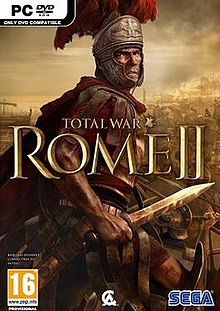Total War Rome II
| Total War: Rome II | |
|---|---|
 |
|
| Developer(s) | The Creative Assembly |
| Publisher(s) | Sega |
| Composer(s) | Richard Beddow |
| Series | Total War |
| Engine | Warscape |
| Platform(s) | Microsoft Windows, OS X |
| Release |
Microsoft Windows
TBA |
| Genre(s) | Turn-based strategy, real-time tactics |
| Mode(s) | Single-player, multiplayer |
| Aggregate scores | |
|---|---|
| Aggregator | Score |
| GameRankings | 76.67% |
| Metacritic | 76/100 |
| Review scores | |
| Publication | Score |
| Edge | 7/10 |
| Eurogamer | 7/10 |
| Game Informer | 8/10 |
| GameSpot | 8/10 |
| GamesRadar+ | |
| GameTrailers | 7.2/10 |
| IGN | 8.8/10 |
| The Guardian | |
| PC Gamer | 85/100 |
Total War: Rome II is a strategy game developed by The Creative Assembly and published by Sega. It was released on 3 September 2013 for Microsoft Windows and is the eighth standalone game in the Total War series of video games. Rome II is a successor to the 2004 game Rome: Total War.
The game released to mostly positive reviews from critics, but suffered from significant technical problems upon release. However, it proved a commercial success, surpassing all other games in the Total War series in both sales and number of concurrent players on its release day.
In September 2014, the Emperor Edition was released, which added Mac support, addressed many of the technical problems in the game, as well as overhauling AI battles and upgrading the visuals. It was offered as a standalone edition and a free upgrade to all current players.
Total War: Rome II is set in the classical antiquity period, and provides a more sophisticated portrayal of each culture, which in the original game had been portrayed anachronistically. The grand campaign begins in 272 BC, and lasts for 300 years. However, the player also has the option to play further, as there are no timed victory conditions.
The Warscape engine powers the visuals of the game and new unit cameras allow players to focus on individual soldiers on the battlefield, which may contain thousands of combatants. Creative Assembly has stated that it wishes to bring out the more human side of war, with soldiers reacting as their comrades get killed around them, and officers inspiring men with heroic speeches.
Armies and navies have changeable stances on the campaign map. Stances determine factors such as total movement points per turn or the ability to deploy traps for an ambush. The "Forced March" stance allows an army to march further, but will tire out its men, reduce their fighting ability and leave them vulnerable to ambush; the "Defensive Stance" enables fortifications such as stakes or redoubts, and the "Ambush Stance" enables traps such as fireballs and sulphur pits. Armies and fleets can be a maximum of 20 units, and must have a general or admiral to lead them. A faction's power, or "imperium", determines the number of armies it can raise. A faction can gain more imperium by conquering more regions or acquiring more gold. Players can also name units in an army and change their emblems.
...
Wikipedia
